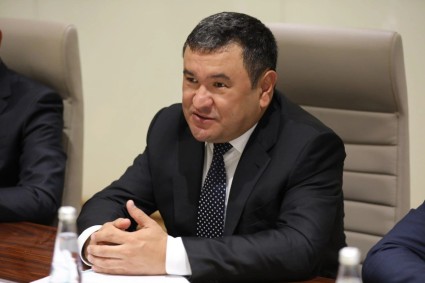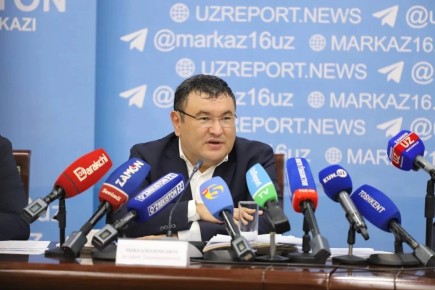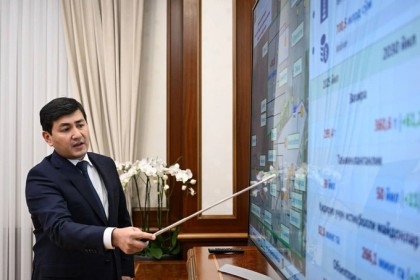An International Monetary Fund staff team, led by Mr. Ron van Rooden, met with the authorities of Uzbekistan during November 7–15, 2022 to discuss economic developments and prospects, as well as policy priorities. At the end of the mission, Mr. van Rooden issued the following statement:
Uzbekistan’s economy has continued to perform strongly this year, despite new headwinds posed by Russia’s invasion of Ukraine, global price pressures, and a tightening of global financial market conditions. Contrary to expectations earlier this year, money transfers, including remittances, more than doubled, and together with continued fiscal support and resilient trade this has supported economic activity and growth in Uzbekistan. As a result, Uzbekistan’s economy is projected to grow by almost 6 percent in 2022.
Inflation has increased and become more broad-based, reflecting rising prices globally, especially of food and energy. Thanks to the Central Bank of Uzbekistan’s (CBU) decisive and timely actions, inflation is expected to remain contained at about 12 percent by end-2022.
Additional headwinds lie ahead, and uncertainty is large. Global economic growth is projected to slow in 2023 and, despite this slowdown, inflation could prove more persistent. As a result, and while domestic demand is expected to remain relatively buoyant, economic growth in Uzbekistan is projected to slow somewhat in 2023, to just under 5 percent. Inflation is expected to remain elevated. Downside risks to Uzbekistan’s economic outlook include risks stemming from a possible further escalation of the war in Ukraine, while global growth could slow further, and financial conditions could deteriorate.
Navigating the current uncertain environment will require increased vigilance. Inflation remains the most immediate threat to current and future prosperity by squeezing real incomes and undermining macroeconomic stability. Failing to tackle inflation risks that it becomes entrenched, increasing the eventual cost of bringing inflation under control. Thus:
- Monetary policy needs to remain firmly focused on reducing inflation. The current policy stance appears appropriate to contain price pressures and gradually bring inflation down to the CBU’s medium-term objective. Policy transmission remains constrained, however, by a low level of financial intermediation and high dollarization, and government lending programs at preferential interest rates. Monetary policy may need to be tightened if food and energy price pressures feed more broadly into core inflation, to avoid that inflation expectations become un-anchored. Preferential lending programs should be reduced further and replaced by interest rate subsidies for critical activities
- Fiscal policy will need to be supportive of the efforts to bring down inflation. The pace of fiscal consolidation was reduced this year, to allow for a more than doubling of social assistance. Thus, the budget deficit is expected to reach 4 percent of GDP in 2022. The authorities rightly aim to reduce the deficit to 3 percent of GDP in 2023, also to anchor confidence in fiscal sustainability. Lowering the deficit may prove challenging given rising structural spending pressures and the desire to reduce taxes. Fiscal policy should continue to protect the most vulnerable through targeted support, but other spending may well need to be curtailed further given risks to revenues from the reduction in the VAT rate and lower gold prices. Efforts to broaden the tax base by eliminating exemptions and improving compliance should continue. There remains scope to further strengthen public investment management, as well as fiscal risk management, including by setting firm rules and limits for public-private partnerships.
Despite the headwinds, the authorities are continuing with market-oriented structural reforms, to enable a shift from public to stronger private sector-led growth. Building on the impressive progress already made in recent years, this will entail reducing the still large role of the state in the economy and further improving the business environment. Small and medium-sized enterprises—which will need to be the main source of new jobs for the rapidly growing labor force—will especially need to be able to grow and flourish. This will require:
- Continuing with the privatization of state-owned enterprises and state-owned banks. The new privatization law will help to ensure that this will be done through transparent and competitive processes. Meanwhile, it is crucial to continue to improve corporate governance and transparency in state-owned enterprises and state-owned banks.
- Enhancing competition and creating a level playing field for businesses. This requires further opening up internal markets to entry by private firms and eliminating privileges for state-owned enterprises, as well as adopting the new competition law and ensuring the independence and adequate powers of the anti-monopoly committee.
- Expanding digitalization of government services, including tax and customs administration. Besides making it easier for businesses to operate, this will also help to reduce the scope for corruption. Governance can be improved by strengthening beneficial ownership requirements, notably for large construction and infrastructure projects, to avoid capture by vested interests.
- Improving factor markets, notably labor, land, energy, water, and finance, to bolster productivity. The new labor code will help facilitate job creation, but improvements in education are urgently needed, especially in vocational and higher education, to address the large skill mismatches. Land reform should be accelerated, including in agriculture, to provide secure and tradable land rights. Energy and water tariffs will need to be raised gradually to cost recovery and then to market levels, to increase efficiency and attract further investment, free up budget resources for more pressing spending needs, and help with the shift toward a greener economy. Raising tariffs should be accompanied by adequate support for vulnerable households. Efforts to reduce the large role of the state-owned banks in the banking system and capital market reforms need to continue to enhance financial intermediation and access to finance.
- Increasing trade integration and regional cooperation. While the current geo-political environment poses ample challenges, it also offers opportunities for attracting businesses that seek to relocate. Accelerating WTO accession negotiations and increased cooperation with neighboring countries, including to improve and create new transport routes, will help to make Uzbekistan an attractive investment destination.
As the authorities continue with sound macro-economic policies and reforms, growth is expected to remain strong in the years ahead. This would allow the authorities to reach their goal of Uzbekistan becoming an upper middle-income country by 2030.












